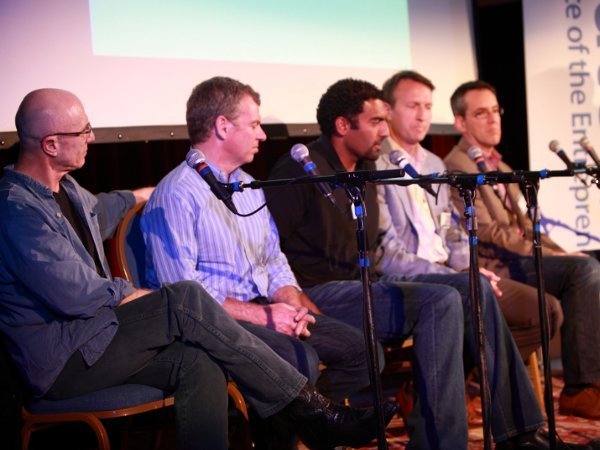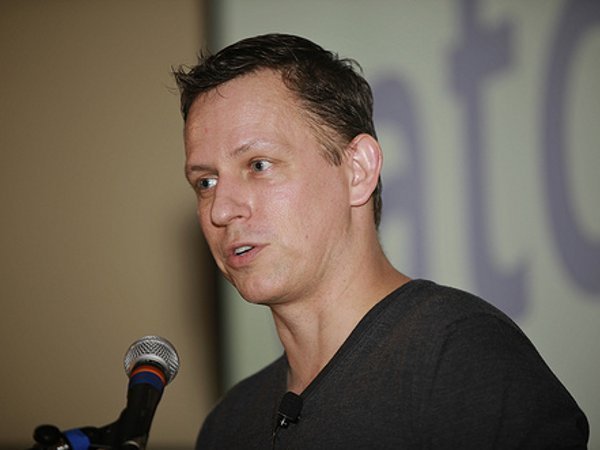 In his introductory remarks at Wednesday night’s Venture Shift event in San Francisco, Bullpen Capital managing director Paul Martino pointed out the irony of the fact that venture capital is grounded on the concept of investing in disruptive new industries and technologies, but the venture capital industry itself has remained largely undisturbed for the last several decades. Now, with angels, super angels, and incubators on the rise, the VC industry is being forced to negotiate new, uncharted investing waters.
In his introductory remarks at Wednesday night’s Venture Shift event in San Francisco, Bullpen Capital managing director Paul Martino pointed out the irony of the fact that venture capital is grounded on the concept of investing in disruptive new industries and technologies, but the venture capital industry itself has remained largely undisturbed for the last several decades. Now, with angels, super angels, and incubators on the rise, the VC industry is being forced to negotiate new, uncharted investing waters.
A few interesting facts emerged in a panel that included Phil Black of True Ventures, Raj Kapoor from Mayfield, Rob Hayes of First Round Capital, Howard Hartenbaum of August Capital, Randy Komisar from Kleiner Perkins, and moderated by Rich Melmon of Bullpen. One is that angels are on the rise and here to stay. The other is that Raj Kapoor is crazy tall.
Here are some highlights from the panel’s discussion on how angels are changing the VC industry.
 Rich: There’s probably been some contention about this old versus new dichotomy, and the premise is this: two major things have happened in the last five years. One is that it takes much less money to get a deal to the first proof of performance than it used to. Second, there’s been an enormous proliferation of deal types. I’d like the panelists to discuss their experiences being part of the insurgency and the reaction from the old guard.
Rich: There’s probably been some contention about this old versus new dichotomy, and the premise is this: two major things have happened in the last five years. One is that it takes much less money to get a deal to the first proof of performance than it used to. Second, there’s been an enormous proliferation of deal types. I’d like the panelists to discuss their experiences being part of the insurgency and the reaction from the old guard.
Howard: I argued a little with Bambi [Francisco]. I’m not so sure this is as big a deal as it’s made out to be. There’s new interest into the venture model, but that’s not all companies. More competition is great. I think it comes down to what is the entrepreneur looking for? Are you looking for a lot of people to help you out? Are you looking for a big organization to help you out? The biggest change I’ve seen in the last few years is how people describe their funding. Five years ago, $30K was friends and family, $100K was seed funding, $1 million was series A, and $5 million was Series B.
Phil Black: the story for us is we founded a company in 2005 and when you start a brand new venture firm, you have to answer the question: why do we need another venture firm, and why are you people the ones to do that? The cost of funding companies has been decreasing. We’ve raised three funds between $165 and $2 million. It’s a truism that it takes dramatically less capital to fund a company, but as you grow and you want to scale a very large business, you can’t do that for free, and you can’t do that on the back of customer revenue. That’s a trend that we’ve seen. It’s a very different time today than it was five, ten, fifteen years ago.
Raj: I think there’s a segmentation going on with money. There are larger and larger funds being created.
Having this institutionalization on the angel side is really good for entrepreneurs. At the same time, the fundamental issue on the internet is that usage typically precedes monetization, which creates a role for capital. I really think it’s more of a segmentation than one is dead and one’s alive.
Rich: What does it mean to be part of this transition?
Rob Hayes: Five years ago we wrote smallish checks and got really engaged. I had a number of meetings with VCs who were very supportive, and I seemed to get this response like… “That is so CUTE what you guys are going!” Our job is to make our shareholders shitloads of money. We saw a huge gap in the market where there are companies that only need a million or a half million dollars to get their businesses going, but there aren’t a lot of people out there who can write a half million dollar check given the structure of their fund. It seemed like an obvious thing to do, so that’s what we did.
Randy: I’m in the service business, not in the capital business. We invest in green, late-stage green, late-stage digital. If you look at our portfolio, the way in which we work with companies is more similar than different than it was 30 years ago. It’s contextual to understand what’s going on in this industry. In a way, nothing’s nicer for me than to see all the risk taken out in a market that has no barriers to entry.
The business of being an entrepreneur has changed. There’s a cost to this new model: you have a million competitors.
Rich: Phil and Rob, do you feel like you’re competing with bigger funds? Is this a really competitive situation?
Phil: The more traditional venture firms are more interested in the slightly vetted opportunity that seems to be working, and then they’re able to deploy their networks and get a lot done. We’ve co-invested with everyone here on this panel, the real competition is in the $5 million plus round. There’s so much more capital for a slightly more established to much more established company.
Rich: Are you in competition with Kleiner? Is there a sense that the lean investor is differentiated from the old guard?
Rob: Often it’s like, two guys and a dog and an idea, but they’ve never started a company before. They’re trying to hire their first few people and set up their first office. The network that someone like Randy can bring to them…they’re only going to completely fuck up what they’re doing. Except for the dog—it’s part poodle so it’s really smart. Anybody that’s had a baby and has had a baby nurse, a night nurse—it’s a fantastic invention, but it’s very different from a babysitter. It’s a different skill set. The baby nurse wants to make sure the baby doesn’t die. But the babysitter wants to make sure the kids aren’t playing video games all day. That’s the difference between what we do…our competition is with the people who do the rounds after us.
Rich: Are lean deals really different conceptually than things before that took $5 million to get started? At EA, we raised $4 million to get started.
Raj: There are differences. It’s a very competitive market, there’s a lot of capital, and you have to know how to maneuver in your sector and move fast.
Rich: As a venture guy trying to make sense out of the deals that walk in the door, are there new challenges in dealing with this, or are they the same things we dealt with before?
Howard: It’s the same thing it was before. The most interesting companies are the ones who are a little more unusual. I think the business really hasn’t changed much. We all have to adapt to a new routine, a new market that comes in the door, and either we’re open minded, or we focus on the past, in which case none of us succeed as investors.
Rich: when I first heard about AirBnB, I thought, no way. But this is the kind of deal we’re investing in now.

Randy: It all comes down to great people. After 25 years of being in the valley, I know you have to identify good people working on an interesting problem. Half of my deals were incubations, entrepreneurs interested in problems I’m interested in who don’t even have an idea, but are willing to work with me on these problems. The other half are series As. I had an opportunity to invest in Groupon when it was The Point, and I wish I had, but at the time, they were uninvestable. You still need to bring the resources appropriate to the opportunity. It’s a process that needs to be understood historically and contextually.
Rich: How does the money funding the funds deal with this new complexity?
Phil: At the end of the day, everyone likes making money. You can tell someone a bunch of wild ideas, but there comes a day of reckoning, and if you’ve made money over a long period of time, then you’re successful, but if you haven’t, then you enter the walking-dead phase. The limited partners are aware of changes. There is a fair amount of bifurcation happening.


















